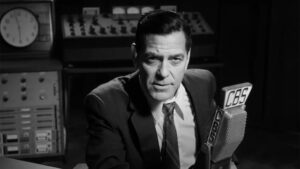
Something bothered me in a clip of George Clooney portraying Edward R. Murrow in the new Broadway production of his 2005 movie, “Good Night and Good Luck.”
It’s not that Clooney isn’t up to the role. It’s that whenever he’s doing a televised Murrow segment, he’s turned sideways at a desk and looking into a camera, with the audience seeing him projected in an image above.
That’s not what theater is supposed to be. When I pay big bucks to watch a play or musical, I want to be able to see the cast members’ faces and expressions. If I wanted to see the Murrow story on a TV screen, I would stream the movie (in which David Straitharn was great as Murrow, with Clooney as producer Fred Friendly) in my living room.
But more and more Broadway shows are using cameras on stage in an attempt to inject technology where it doesn’t belong and isn’t necessary.
The recent Andrew Lloyd Webber production of another film-to-stage show, “Sunset Boulevard,” had big screens all over the place. When faded silent screen actress Norma Desmond said the most famous line from the movie, “I’m ready for my close-up, Mr. DeMille,” sure enough, a big in-her-face camera shot was projected. And there was a sequence where the male lead, Joe, is shown to the audience live via video singing the show’s title tune as he leaves his dressing room, descends seven flights of stairs backstage and strolls out onto 44th Street. Then he walks half a block before turning back into the theater to wrap up the tune onstage.
Why do it that way? I give credit to the camera crew walking backwards while shooting him and to the actor for continuing to perform while surrounded by traffic on the street and gawkers on the sidewalk — especially on nights when it was raining. But it was merely a “look what we can do” sequence from director Jamie Lloyd which didn’t add anything to the show.
Another current Broadway production stars Sarah Snook (Shiv Roy on HBO’s “Succession”) in “The Picture of Dorian Gray,” in which she plays all twenty-six characters. But according to TDF.org:
Although it is a one-woman tour de force, as many as 20 others share the stage, forming an ensemble of camera operators, stage managers, costume assistants to facilitate Snook’s quick changes and crew members to move set pieces around. Director Kip Williams, who also adapted the novel for the stage, describes the production as “cine-theatre.”
Six years ago, Martha and I saw Bryan Cranston as Howard Beale in the Broadway adaptation of Paddy Chayefsky’s “Network.” It was directed by Ivo van Hove, who loves to integrate video in his shows. While I liked the show a lot, I said this in my review:
My one objection to the staging is that several of the scenes are played upstage left, out of view from my side of the audience, blocked by the glass-walled control room on the set. An on-stage camera crew with Steadicams allows access to all the conversations via the big screen, but it would have been nice not to have to watch so much of the show in that 2-D form when the actors were right there.
Theatre is supposed to be presented in all three dimensions, not reduced to a flat sixteen-by-nine projected image. When Clooney is doing the TV segments of “Good Night and Good Luck,” he should be right up there at the front of the stage, so the audience can see him straight on, not working to a camera operator whose job is to just keep him in the frame.
Not so incidentally, the production of “Network” we saw also included a scene performed on the sidewalk in front of the theater as Tatiana Maslany and Tony Goldwyn did a walk-and-talk shown to the theater audience via video. As with “Sunset Boulevard,” it contributed nothing to the actual show, yet another example of a director showing off their toys.
One of the things that makes live theater so special is we can change our perspective by deciding what we want to look at. Instead of keeping our eyes glued to the star, we can glance over at the supporting cast to see what they’re doing and how they’re reacting. We’re the ones in charge of how we absorb what’s happening on stage. That’s a choice we’re robbed of when forced to watch the proceedings on a two-dimensional projection.
For the record, while Martha and I plan to return to New York this spring to take in some shows, we will not be seeing “Good Night and Good Luck” or “The Picture Of Dorian Gray” because the ticket prices are so high. For aisle seats — which I need because I’m a large person with long legs that would be severely cramped in the middle of a row — those shows cost more than $400 apiece. That’s way too much to pay to watch TV.
Still, they’re not as expensive as the new production of Shakespeare’s “Othello,” starring Denzel Washington and Jake Gyllenhaal. “60 Minutes” did a piece on the show and said it’s breaking records for how much it’s making. I think I know why: a single ticket could set you back more than $900.
By the way, during the “60 Minutes” piece, Denzel said this version of “Othello” is the best thing he’s ever done. Do any actors ever say the new project they’re involved in isn’t really that good? Or name something they did two decades ago as fantastic and this doesn’t come close to that?
Whether he means it or not, he still has to say it. Gotta fill those nine hundred dollar seats.
